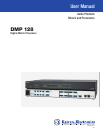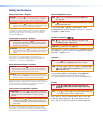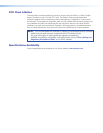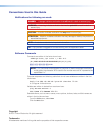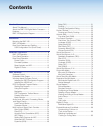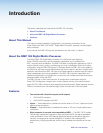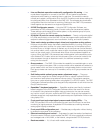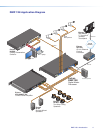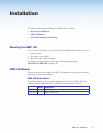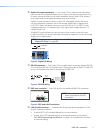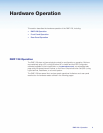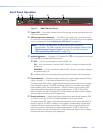
• Digital audio expansion port for linking two DMP 128 units — An expansion
port allows any two DMP 128 models to be linked together via a single shielded
CAT6 cable. This allows eight matrix mixes of the inputs, plus eight virtual paths to be
sent and received between units.
• Automixer with eight gate groups — The DMP 128 features an automixer with
advanced features for managing signal levels from multiple microphones. The
automixer includes a gating mode that automatically gates channels on or off, as well
as a gain sharing mode that maintains the overall system gain based on the number
of active mics.
• ProDSP™ audio signal processing — The DMP 128 features 32/64-bit floating
point audio DSP processing, which maintains very wide dynamic range and audio
signal transparency, to simplify management of gain staging while reducing the
possibility of DSP signal clipping.
• 48 volt phantom power — The DMP 128 is equipped with selectable 48 volt
phantom power for the first eight inputs, allowing the use of condenser microphones.
• Studio grade 24-bit/48 kHz analog-to-digital and digital-to-analog converters
— Professional converters fully preserve the integrity of the original audio signal.
• Fixed, low latency DSP processing — Input to output latency is low within
the DMP 128 and stays constant, regardless of the number of active channels or
processes. While latency increases marginally on channels with AEC enabled, overall
latency remains low. Fixed latency processing keeps audio in sync with video, and
prevents distractions to presenters or performers resulting from delayed live audio.
• DSP Configurator™ Software — A powerful yet user-friendly PC-based software
tool for managing all audio operations of the DMP 128. It enables complete setup
and configuration of digital audio processing tools on the ProDSP platform, as well as
routing and mixing.
• Intuitive Graphical User Environment — The DSP Configurator Software features
a Graphical User Environment that offers a clear view of all input and outputs, audio
processing blocks, routing, mix-points, and virtual routing in a single screen. This
allows a designer or installer to quickly view an audio configuration without having to
access multiple dialog boxes or menus.
• Device Manager enables configuration of multiple Extron DSP products
— Device Manager in the DSP Configurator Software enables easy configuration of
multiple Extron DSP products, including two linked DMP 128 processors, by toggling
between Graphical User Environments for each unit. Processors can be grouped into
folders for organizing as separate rooms or buildings. Settings for multiple Extron DSP
products in Device Manager can be saved to a single file.
• Flexible control options — The DMP 128 can be controlled using the DSP
Configurator Software and a PC connection to the Ethernet port, the RS-232 serial
port, or the USB 2.0 port on the front panel. The DMP 128 can also be controlled
through a control system with Extron SIS™ - Simple Instruction Set commands, and
by accessing the internal Web pages.
• Copy and paste for processing blocks — To help speed audio system design
and setup, parameter settings can be quickly copied between individual processing
blocks or identical groups of blocks within the Graphical User Environment, using
conventional cut-and-paste commands.
• Building Blocks processor settings — A collection of pre-designed processor
settings optimized for a specific type of input or output device, such as microphones
and Extron speakers, with preset levels, filters, dynamics, and more. Flexible Building
Blocks are available on each I/O strip and allow system designers to fully customize
and save their own Building Blocks, further streamlining audio system design and
integration.
DMP128 • Introduction 2



